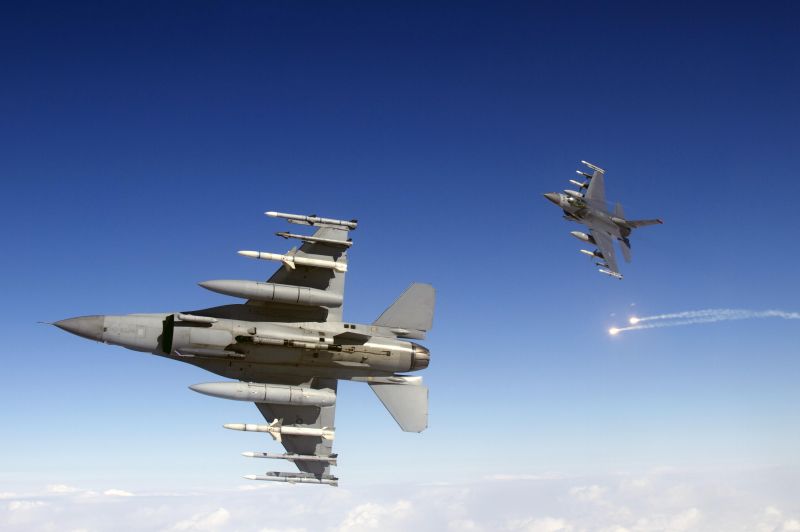Groundbreaking advancements to F-16 Fighting Falcon warfare training here arrived during the week of Aug. 12 through 16 in the form of a Joint Deployable Electronic Warfare Range, or JDEWR.
The JDEWR is a weapon system that provides tactical-level training to participants in live training events. It’s implemented as a threat capable of submitting ground threat defenses for bilateral and joint missions and exercises for United States Air Force, Japan Air Self-Defense Force and Navy aircraft stationed here, according to Lt. Col. Kevin Jones, 35th Operations Support Squadron director of operations.
The mission of the 35th Fighter Wing is the Suppression of Enemy Air Defenses – known as the Wild Weasels — and focuses largely on the neutralization of enemy Surface to Air missile sites. In the past, Wild Weasels have had to fly to Red Flag exercises over Eielson Air Force Base, Alaska, which use the JDEWR system, to get the most accurate training possible for their SEAD mission.
“As a SEAD wing, we need to be able to detect, locate, engage and kill enemy SAMs, antiaircraft artillery and their associated radars,” said Capt. Matthew Karmondy, an F-16 pilot in the 14th Fighter Squadron who has flown in multiple Red Flag exercises. “The more our training matches reality, the better we’ll be when the balloon goes up and we are called on to neutralize enemy threats.”
Karmondy said once a SAM is located, the next step is how to best neutralize that threat, whether it be through avoidance, electronic jamming or kinetic means such as bombs, missiles or guns. Pilots were previously forced to simulate these attacks, and one of the realities was that the aspect of realistic feedback from the ground always fell short. Now, with this new system, pilots can fight back realistically, utilizing all aspects within the cockpit.
“That’s exactly what the JDEWR allows us to do – train like we will fight in major combat operations,” Karmondy said. “Short of putting missiles and bullets in the air, the JDEWR fights back. It’s a hugely important asset.”
Capt. Travis Smith, 35 OSS electronic warfare officer, said the JDEWR can simulate up to seven different target systems simultaneously in its current configuration.
“It’s rapidly re-deployable as well, so we could have vastly different set ups for the pilots to fly against from exercise to exercise in our own backyard,” Smith added.
Before the JDEWR’s arrival, Jones said “We didn’t get to see a real threat on the radar looking at us — nothing triggered our radar warning receiver. But now the arrival of the JDEWR gives the ability to actually get a spike and act accordingly to that threat.”
Having the equipment here for a realistic threat environment also postures Misawa to potentially host large scale exercises in the future, boosting value in regional training with other military assets.
“Joint and bilateral training is significant in that it’s just the reality of how we are going to go to war in today’s day and age,” Jones said.
The Japan Ground Self-Defense Force has provided noteworthy assistance to Wild Weasels in recent months by opening up their SAM sites for training, albeit their availability was often limited, Karmody said.
The arrival of the JDEWR makes Misawa and its surrounding airspace a top-of-the-line training forum available 24/7.
The JDEWR is the first of its kind to be placed in Japan and will be based at Misawa’s Draughon Range, an area located only 10 nautical miles north of the base where pilots are authorized to drop live ordnance during training.
Jones said Draughon Range is “one of the best kept secrets in the Air Force,” lauding its ability to provide both tactical and conventional targets, while also being the only air-to-ground range in Northern Japan.
“It’s great to see pilots learn on Draughon Range by practicing their attacks and growing as pilots,” said Capt. Greg Balzhiser, 13th Fighter Squadron F-16 pilot. “You can actually see the results on the ground right in front of you rather than having to simulate the results of an attack.”
35 FW pilots generally fly in two airspaces – the Charlie airspace, a massive area located along the entire northwest coast of Japan, and the Bravo airspace to the east, which encompasses the valuable Gaicho airspace.
The Gaicho airspace was made available earlier this year and has played a large role in the comprehensive and innovative efforts of Misawa AB to become globally recognized in extensive fighter jet training. Gaicho airspace feeds off the east side of Draughon Range and expands the airspace approximately 50 miles over the Pacific Ocean to bridge the gap between Bravo airspace, providing pilots significant more space to engage in variations of combat training scenarios.
1st Lt. Dustin Carey, 13 FS F-16 pilot, said it’s some of the best airspace in the world, and adding the JDEWR to the mix allows pilots to explore the full range of tactics in warfare.
“The JDEWR is absolutely imperative,” Carey said. “We’re the world’s greatest Wild Weasels, and now that we have the emitter we’ll be able to train exactly like we fight which is absolutely incredible.”
Smith said the diversity of training won’t stop with the JDEWR, and systems such as fidelity simulators, different modes within the jet, and even commercial, off-the-shelf hardware are used to practice against.
“We’re constantly looking at the mission set and thinking about ways to augment training so that the 35th Operations Group will be more than ready for the fight,” said Smith.
The JDEWR will be operated by contractors within Pacific Air Forces that have wide-ranging experience with Large Force Employment training, namely Red Flag, and in time will be training others to take over the operations here.
Jones said this prospect was made possible by determined coordination between 5th Air Force, PACAF and U.S. Forces Japan, and that base officials are working a plan to make this a permanent fixture here.










